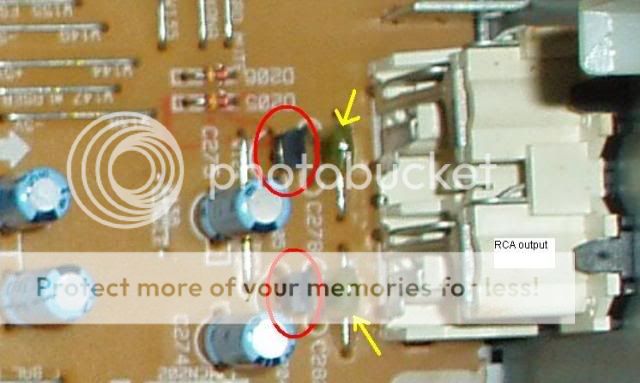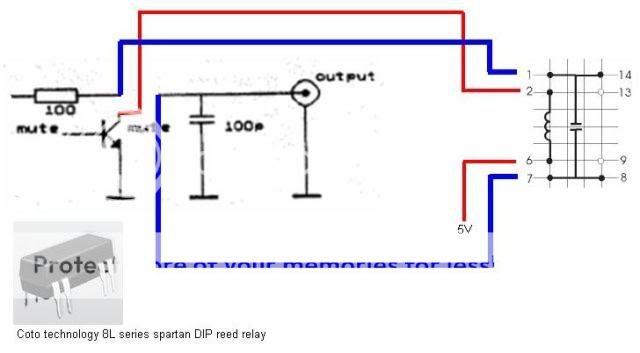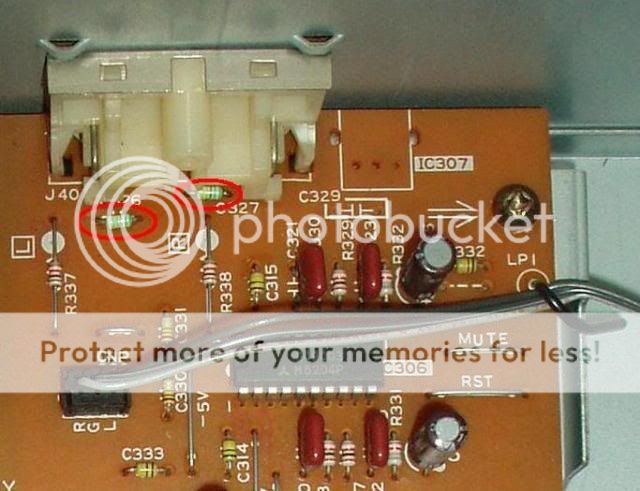Hi all,
Need some suggestion here. I don’t have the schematic of my old LD player.
I think those 2 circle in red are muting transistors, am I right? I understand removing them completely yields better sound.
What about the 2 caps (yellow arrows pointing)? Should I remove them too?
Thanks!

Need some suggestion here. I don’t have the schematic of my old LD player.
I think those 2 circle in red are muting transistors, am I right? I understand removing them completely yields better sound.
What about the 2 caps (yellow arrows pointing)? Should I remove them too?
Thanks!

Removing them does help, but it causes audible clicks at power up and power off, and sometimes when changing tracks.
Also in my NAd C521, when you were seeking within the track it would emit a very loud sound from the speakers, as the muting transistors were supposed to reduce that level also. Of course one never uses that function as much, so I left them out.
Unwise to remove caps without at least knowing what they do. May or may not work. They look like bypass caps for the output caps, or maybe a small amount of local feedback for the transistor itself, can't really say.
Also in my NAd C521, when you were seeking within the track it would emit a very loud sound from the speakers, as the muting transistors were supposed to reduce that level also. Of course one never uses that function as much, so I left them out.
Unwise to remove caps without at least knowing what they do. May or may not work. They look like bypass caps for the output caps, or maybe a small amount of local feedback for the transistor itself, can't really say.
You can also physically modify the circuit to allow those transistors to drive small reed relays that shunt the output to ground when mute is needed. (Normally open contacts) Unlike the transistors they are not audible when turned off.
Use 5V reed relays - cut the collector etch (NPN assumed, but not always the case) so it is no longer in the signal path, connect one side of relay coil (add shunt diode if not already in relay) - other side of coil goes to +5V which in older players is generally available. Connect the n.o contacts of relay across audio output and ground.
This is generally a pretty easy mod and eliminates bad noises without the degradation caused by the transistors.
Use 5V reed relays - cut the collector etch (NPN assumed, but not always the case) so it is no longer in the signal path, connect one side of relay coil (add shunt diode if not already in relay) - other side of coil goes to +5V which in older players is generally available. Connect the n.o contacts of relay across audio output and ground.
This is generally a pretty easy mod and eliminates bad noises without the degradation caused by the transistors.
Hi Kevin,
Yes, I agree.
However, I would use the normal signal relays. DPDT. You can find them sealed and gas filled so that they last much longer. Use them to short the signal to ground as the transistors did. The transistors were 2SC2878, weren't they? (Don't lose them, they are special types)
Hi Calamaro,
What you suggested is ill advised. Some players implement the EQ correction in the analog section. That and if you bypass the analog filters, you are allowing the sampling frequency out of the box. You certainly will not get the correct time constants or filter shape.
If those parts didn't need to be there, they would not have been paid for and installed by the manufacturer. The "other garbage" is carefully designed. Can it be improved? Maybe. Are those circuits garbage? No!
-Chris
Yes, I agree.
However, I would use the normal signal relays. DPDT. You can find them sealed and gas filled so that they last much longer. Use them to short the signal to ground as the transistors did. The transistors were 2SC2878, weren't they? (Don't lose them, they are special types)
Hi Calamaro,
What you suggested is ill advised. Some players implement the EQ correction in the analog section. That and if you bypass the analog filters, you are allowing the sampling frequency out of the box. You certainly will not get the correct time constants or filter shape.
If those parts didn't need to be there, they would not have been paid for and installed by the manufacturer. The "other garbage" is carefully designed. Can it be improved? Maybe. Are those circuits garbage? No!
-Chris
Hi guys,
Thanks for the suggestion. I found a 8L series Spartan DIP reed relay (5V) from Coto Technology, I’m not sure whether it has a shunt diode built-in & if it’s suitable for this application.
Hi Kevinkr,
Based on your description, is the circuit u mentioned should connect like this –

I have not take a closer look at the transistors, so I’m not sure if they are 2SC2878.
Thanks for the suggestion. I found a 8L series Spartan DIP reed relay (5V) from Coto Technology, I’m not sure whether it has a shunt diode built-in & if it’s suitable for this application.
Hi Kevinkr,
Based on your description, is the circuit u mentioned should connect like this –

I have not take a closer look at the transistors, so I’m not sure if they are 2SC2878.
You have the relay in series with the signal. I think you want it to short the output to ground, so when open, it is no longer in the circuit. That is the way the original mute xsistor worked. So, just keep the RCA connected, and connect the relay from RCA output to ground. That will also restore the correct phase: in your circuit, mute is off when activated and on when deactivated, just the wrong way around.
Jan Didden
Jan Didden
Jan understood what I meant, the relay shunts the signal just as the transistor did, it is not in series with it.
Make sure you place a reverse biased diode across the relay coil to protect the transistor when the oil de-energizes.
Incidentally good reed relays from Coto or Panasonic will last millions of operations provided not too much dc current is not flowing through them when they switch.
From long experience you really do not want the signal flowing through the contacts unless it is absolutely necessary in which case very expensive relays are generally indicated.
Make sure you place a reverse biased diode across the relay coil to protect the transistor when the oil de-energizes.
Incidentally good reed relays from Coto or Panasonic will last millions of operations provided not too much dc current is not flowing through them when they switch.
From long experience you really do not want the signal flowing through the contacts unless it is absolutely necessary in which case very expensive relays are generally indicated.
Assyst1606 said:Hi guys,
Thanks!
One silly question, so i need to build this circuit one for the "L" RCA & one for the "R" RCA???
What about RCA output with muting caps only? Remove the cap is the only option?
As Chris said, you can use a double-pole relay to mute both at the same time. That is effectively a relay with one coil but two switches, commonly known as DPDT or DPST.
What's a 'muting cap'?
Jan Didden
Hi Assyst1606,
All mute circuits use transistors with either the collector grounded, or the emitter grounded. The collector is in the middle, and the emitter should be the pin on your left if you are looking at the part number with the legs pointed down.
Your "muting capacitor" is a coupling capacitor (C274, C275). It is used to block all DC voltage present from the audio output jacks. You may find that the capacitor follows the muting transistor, so one pin of the transistor would be directly to one side of your capacitor. A little unusual, but they can do this either way.
I'm wondering if they didn't use these transistors for switching the EQ on and off (C278). That would be extremely unusual. Of course these may be some kind of final filter, but more likely to filter the base drive to make sure there is no noise to bleed through to the audio circuit. You would find one capacitor from the base to ground on each transistor.
I was thinking out loud as I posted. Hopefully this helps you some. To be absolutely sure, I'd need to see the schematc.
-Chris
All mute circuits use transistors with either the collector grounded, or the emitter grounded. The collector is in the middle, and the emitter should be the pin on your left if you are looking at the part number with the legs pointed down.
Your "muting capacitor" is a coupling capacitor (C274, C275). It is used to block all DC voltage present from the audio output jacks. You may find that the capacitor follows the muting transistor, so one pin of the transistor would be directly to one side of your capacitor. A little unusual, but they can do this either way.
I'm wondering if they didn't use these transistors for switching the EQ on and off (C278). That would be extremely unusual. Of course these may be some kind of final filter, but more likely to filter the base drive to make sure there is no noise to bleed through to the audio circuit. You would find one capacitor from the base to ground on each transistor.
I was thinking out loud as I posted. Hopefully this helps you some. To be absolutely sure, I'd need to see the schematc.
-Chris
Hi Chris,
Thanks! I'll check it out.
I had a look at my old Sony CD player. This one uses caps (no transistor) at the RCA output, they are connected across the RCA terminal.
So i guess the only option is to remove them completely. Can't put in a relay.
Will i get noise too during ON/OFF the player?

Thanks! I'll check it out.
I had a look at my old Sony CD player. This one uses caps (no transistor) at the RCA output, they are connected across the RCA terminal.
So i guess the only option is to remove them completely. Can't put in a relay.
Will i get noise too during ON/OFF the player?

Hi Assyst1606,
No, leave them in there. They are used as filters to reduce the high frequency noise that might leak out otherwise. They are ceramic, so you might replace them with the same value in a film cap, or an NPO ceramic cap. They have nothing to do with muting at all.
IC 306 is probably where your muting takes place, but that chip does other things also. I'd leave that one unless you are willing to track down the information of that IC. I can't clearly see the part number on it - M52??P.
-Chris
No, leave them in there. They are used as filters to reduce the high frequency noise that might leak out otherwise. They are ceramic, so you might replace them with the same value in a film cap, or an NPO ceramic cap. They have nothing to do with muting at all.
IC 306 is probably where your muting takes place, but that chip does other things also. I'd leave that one unless you are willing to track down the information of that IC. I can't clearly see the part number on it - M52??P.
-Chris
- Status
- This old topic is closed. If you want to reopen this topic, contact a moderator using the "Report Post" button.
- Home
- Source & Line
- Digital Line Level
- Muting transistors
